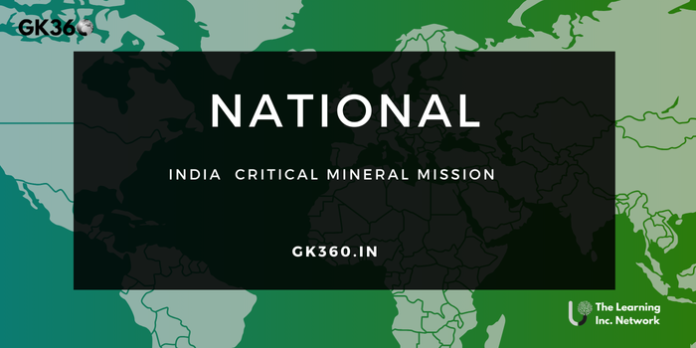India Critical Mineral Mission 2025: Powering the Future with Lithium, Cobalt & Rare Earths
Introduction: Why Critical Minerals Matter for India’s Green Goals
India’s ambitious transition to clean energy is not just about installing solar panels and building EVs—it’s about securing the minerals that make those technologies possible. From lithium and cobalt to rare earth elements (REEs), critical minerals are the backbone of green technologies. Recognizing this, the Government of India launched the National Critical Mineral Mission (NCMM) in 2025—a game-changing policy to secure mineral resources, reduce import dependence, and position India as a leader in the global clean energy race.
Led by the Geological Survey of India (GSI) and coordinated by the Ministry of Mines, this mission is a strategic response to global supply chain uncertainties and India’s growing demand for energy transition materials.

Table of Contents
- What is the National Critical Mineral Mission (NCMM)?
- Objectives of the NCMM: Reducing Import Dependency
- Which Minerals Are Critical for India’s Future?
- Clean Energy Applications of Key Minerals
- Strategic Mineral Stockpiles: India’s Mineral Security Plan
- Four Pillars of NCMM Implementation
- Conclusion: Building a Self-Reliant Green Future
- FAQs
What is the National Critical Mineral Mission (NCMM)?
The National Critical Mineral Mission (NCMM) is India’s flagship initiative launched in 2025 to ensure a resilient and self-reliant supply chain for essential minerals used in green technologies. Spearheaded by the Ministry of Mines, it aims to secure resources critical for solar panels, wind turbines, electric vehicles (EVs), and energy storage systems—technologies at the core of India’s clean energy goals.
The mission is designed to:
- Secure long-term access to key minerals
- Promote domestic exploration and processing
- Establish strategic stockpiles
- Build international partnerships
- Foster R&D and innovation
Objectives of the NCMM: Reducing Import Dependency
The NCMM targets five strategic goals:
- Encourage Domestic Exploration: Reduce overdependence on imports through new mineral exploration efforts.
- Establish Global Partnerships: Acquire overseas mineral assets via public-private collaborations.
- Develop a Full Value Chain: Cover everything from mining to recycling of critical minerals.
- Promote Innovation: Drive R&D and technical skill development in mineral sciences.
- Create Strategic Reserves: Build mineral stockpiles to cushion against global supply shocks.
Which Minerals Are Critical for India’s Future?
In 2022, a high-level expert committee identified 30 critical minerals vital for India’s renewable and industrial strategy. Of these, 24 have been classified under Part D of Schedule I of the Mines and Minerals (Development and Regulation) Act, 1957, empowering the central government to auction them.
Notable Critical Minerals:
- Lithium – battery storage
- Cobalt – EV battery cathodes
- Nickel – battery energy density
- Rare Earth Elements (neodymium, dysprosium) – permanent magnets
- Tungsten – defense and electronics
- Silicon – solar photovoltaics
- Tellurium – high-efficiency solar cells
Clean Energy Applications of Key Minerals
Critical minerals are not abstract resources—they are physically embedded in every solar cell, EV battery, and wind turbine. Here’s how they’re used across India’s green tech spectrum:
Solar Energy & Photovoltaic Cell Minerals
- Installed Capacity (2025): ~64 GW
- Essential Minerals: Silicon, tellurium, indium, gallium
These are used in PV cells, which convert sunlight into electricity.
Wind Power and Rare Earth Elements
- Target by 2030: 140 GW
- Critical Minerals: Neodymium and dysprosium
These REEs are vital for high-strength permanent magnets in turbine generators.
Electric Vehicles and Battery Metals
- EV Target (NEMMP): 6–7 million vehicles
- Battery Materials: Lithium, cobalt, nickel
Used in lithium-ion batteries powering EVs and hybrid vehicles.
Energy Storage for Grid and Mobility
Key minerals like lithium and nickel support:
- Grid-scale energy storage
- Residential solar batteries
- Fast-charging infrastructure
Strategic Mineral Stockpiles: India’s Mineral Security Plan
In line with global best practices, India will establish five strategic stockpiles for critical minerals. These reserves will act as economic buffers to absorb price volatility and prevent supply disruptions in global markets—especially during geopolitical tensions.
Four Pillars of NCMM Implementation
To realize its ambitious goals, the National Critical Mineral Mission is structured around four strategic implementation pillars:
1️⃣ National Exploration Push
India has sanctioned 195 new exploration projects for 2024–25, with a focus on untapped mineral belts.
- Rajasthan leads with 35 projects due to its rich geology.
- Over 100 blocks will be auctioned to private players for development.
- Offshore exploration is gaining traction—particularly in deep-sea areas containing polymetallic nodules with cobalt, manganese, and REEs.
- All exploration activities are aligned with:
- UN Framework Classification (UNFC)
- Mineral Evidence Rules, 2015 (MEMC Rules)
2️⃣ Policy Reforms and Industry Incentives
To attract investment and maximize mineral recovery:
- The Exploration Licence (EL) system has been introduced.
- Recovery from secondary sources like fly ash, e-waste, and red mud is being incentivized to promote a circular economy.
- Liberalized norms have reduced entry barriers for private and foreign players.
3️⃣ International Collaborations for Mineral Security
India is expanding its mineral sourcing footprint through strategic diplomacy:
- KABIL (Khanij Bidesh India Ltd.) leads global acquisition efforts.
- Signed a deal with Argentina’s CAMYEN SE for a 15,703-hectare lithium block.
- MoU signed with Australia’s Critical Minerals Office to enhance bilateral cooperation.
- MEA (Ministry of External Affairs) aligns NCMM with foreign policy to:
- Mitigate geopolitical risk
- Ensure secure supply routes
- Indian enterprises receive financial and technical support for overseas ventures.
4️⃣ Strengthening Domestic Mineral Processing
India is upgrading its domestic value chain to reduce foreign dependence:
- IREL (India) Ltd. is a key player in processing minerals like ilmenite, garnet, and REEs.
- A Rare Earth Extraction Plant is operational in Odisha.
- A dedicated refining unit in Kerala enhances domestic capabilities.
- IREL reported a turnover of ₹14,625 million in FY 2021–22, reflecting its strategic importance.
India in the Global Critical Mineral Landscape
India’s NCMM is part of a broader global trend where countries are racing to secure critical minerals for clean energy dominance.
| Country | Key Moves |
|---|---|
| 🇺🇸 USA | Inflation Reduction Act incentivizes local battery material production. |
| 🇨🇳 China | Controls over 60% of global rare earth processing. |
| 🇪🇺 EU | Launched the Critical Raw Materials Act to diversify sources. |
| 🇮🇳 India | NCMM focuses on exploration, global deals, and circular economy models. |
India’s ability to balance domestic development with international acquisition could make it a pivotal global supplier in the clean tech race.

🙋 Frequently Asked Questions (FAQs)
- What are critical minerals and why are they important for India?
Critical minerals like lithium, cobalt, and REEs are essential for manufacturing clean energy technologies such as solar panels, EV batteries, and wind turbines. They are vital for India’s energy transition and economic competitiveness. - What is the National Critical Mineral Mission (NCMM)?
NCMM is a 2025 government initiative to secure the supply of essential minerals by promoting domestic exploration, creating stockpiles, and acquiring overseas assets. - How will NCMM reduce India’s mineral import dependency?
The mission supports:- Extensive domestic mining
- Investment in processing & refining
- International deals to diversify sourcing
- Recycling and recovery from waste streams
- Which Indian agencies are leading this mission?
- Ministry of Mines
- Geological Survey of India (GSI)
- IREL (India) Ltd.
- KABIL (for overseas asset acquisition)
- What role do critical minerals play in electric vehicles and batteries?
Lithium, cobalt, and nickel are key components of lithium-ion batteries, which power EVs and are also used in grid-scale energy storage solutions.
Conclusion: Building a Self-Reliant Green Future
The National Critical Mineral Mission marks a turning point in India’s green energy revolution. By targeting mineral security through domestic reforms, international collaborations, and circular economy principles, India is creating a strong foundation for self-reliance and global leadership.
As the world shifts to sustainable energy, India’s proactive mineral strategy positions it not just as a consumer, but a strategic supplier and innovator in the clean energy era.
Key Takeaways Table
| Aspect | Details |
| Mission Launch | National Critical Mineral Mission launched in 2025 under Ministry of Mines and GSI. |
| Key Objectives | Domestic exploration, overseas sourcing, full value chain development, R&D, and stockpile creation. |
| Critical Minerals Identified | Lithium, cobalt, nickel, REEs (neodymium, dysprosium), silicon, tungsten, tellurium. |
| Clean Energy Applications | Used in solar PVs, wind turbines, EVs, and energy storage systems. |
| Strategic Mineral Stockpiles | Five national reserves to safeguard against supply shocks. |
| Global Collaborations | KABIL acquisitions in Argentina; MoUs with Australia for lithium and rare earths. |
| Domestic Industry Support | Incentives for mineral recycling, EL licensing, and private sector entry. |





